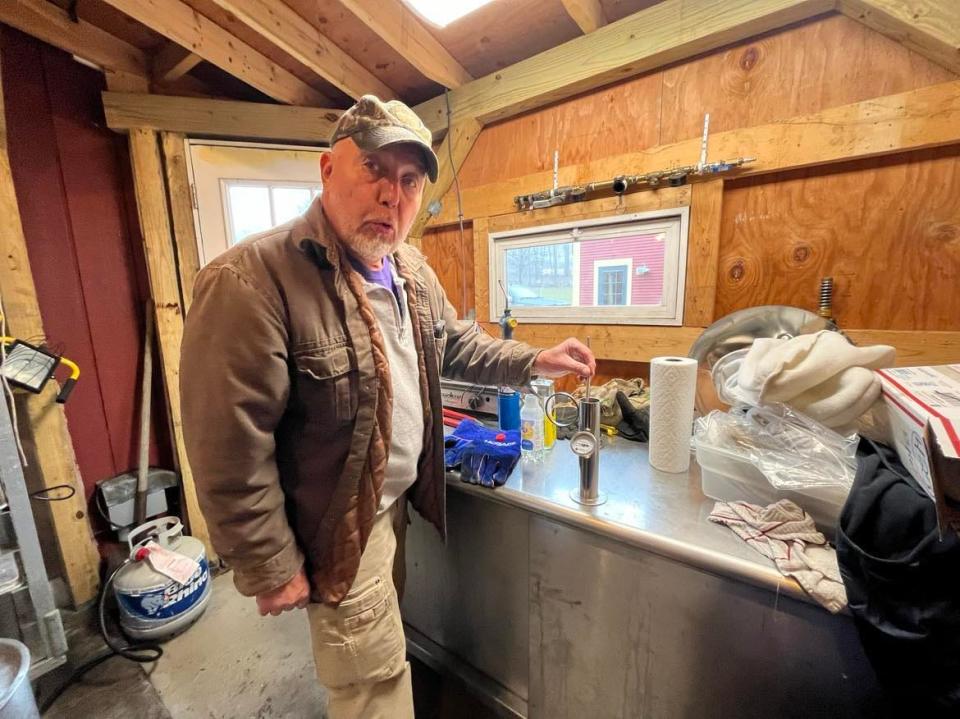How does the mild winter affect maple sugaring? Here's what a Westminster producer said
Von Salmi has committed 38 years to the art of maple syrup, and neither age nor climate change will stop him from practicing his favorite hobby.
In 1987, Salmi built his family's home on 15 acres of land at 41 Bacon St. in Westminster. Right next to the family's brick red home is Salmi's Sugarhouse, and about 8 acres of Sugarbush are used to make the locally known maple syrup.
Salmi said he learned to produce maple syrup from his grandfather. He was reintroduced to the practice in the mid-1980s when his children learned about it in Boy Scouts, and since then, he has been making maple syrup.
As he got older, Salmi said he couldn't walk through all 8 acres of sugar bush to collect sap, but he also doesn't plan to retire from his Sugarhouse anytime soon. He said he had to install a line system instead of the traditional sap bucket system about seven years ago to collect the sap.

"I'm getting older, so the usual way of collecting sap that drips from the tap into a bucket wasn't going to be easy for me," he said. "I have about 200 taps and about 8 acres of sugarbush. I don't want to have to retire from it."
In the past few years. Salmi said he has noticed the milder winters have pressured him and other local producers to shift their traditional maple syrup methods so they can make syrup every season.
Will I be able to get my syrup fix this year?
Although Sugarhouse enthusiasts can still get their favorite local maple syrup, both large and small sugar operations must prepare for many environmental factors every year.
As it gets colder, trees push all their sap, sugar and nutrients to the branches and lose their leaves. When temperatures get warmer, the sap starts to flow back into the roots so the tree can start its budding process. Sugarhouses tap trees right before the sap flows to the roots, so when it does flow, they can collect some before the tree buds and sap stops flowing.
This past winter's lack of snow and below-freezing temperatures have caused producers to shift their tapping and sap-yielding timelines. In the past, sugarhouse producers would start tapping their trees in early March, and the sap would flow from six to seven weeks until mid- to late April.

Now, producers are tapping their trees during the late winter to keep up with the mild temperatures; some tap trees as early as mid-January, with a shorter sap collection of three to four weeks. Salmi said producers are tapping earlier because they are trying to get sap out before the trees bud and dry out.
"You want to get sap out before the tree buds because it gives the maple syrup a budding taste instead of that sweetness," he said. "We noticed maple trees budding sooner because of the warmer winters."
This past week of mid-40s and low-50s temperatures is the first sign that the sugar season is coming to an end. Soon trees will start to bud and sap will dry out.
More: Farmers' Almanac: How close was the Greater Gardner winter forecast? What about spring?
Shift from sugar maple to red maple
In the past 20 to 30 years, maple syrup producers and environmental researchers have noticed a decline in sugar maples in southern New England. The sugar maple used to be the most common maple syrup tree.
Salmi said research assumes the sugar maple population decline is because of an increase of pollutants in the atmosphere and warmer temperatures. Sugar maples need a cold and moist environment to grow and produce sap to make maple syrup.
But as the sugar maple population declines, the red maple population increases. Salmi said red maple trees are more tolerant of warmer climates, so producers and researchers are seeing more of them.
"Red maples appear to be the future of sugarhouses," he said. "The red maple sap is not any different than the sugar maple. The quality and taste are the same."
What are sugarhouses doing to keep the practice alive?
Milder winters does not mean poor-quality maple syrup; it means less time to collect as much maple sap as possible.
Like many small sugarhouse operations, Salmi has relied on technological advancements to keep the tradition of maple syrup alive. For example, Salmi said he uses a vacuum system to draw out sap quicker before the tree dries out.
Also, several New England and Canadian universities, like the University of Vermont, are conducting ongoing research and studies to keep producers informed on the effects of the warming climate on sap.
He said staying informed and aware of one's micro-environment is critical to keeping production going seasonally, especially with the unpredictable weather and warmer winters.
This article originally appeared on Gardner News: New England maple syrup season ends early due to mild weather

